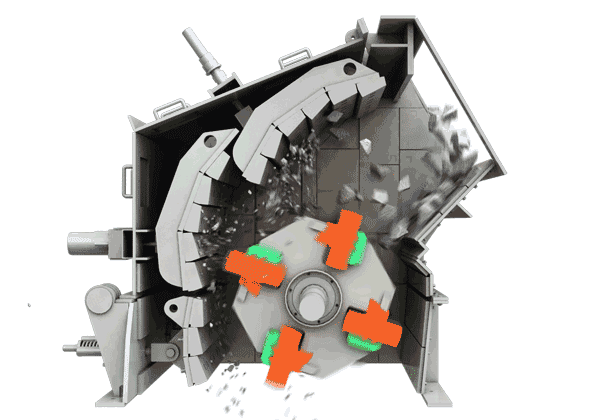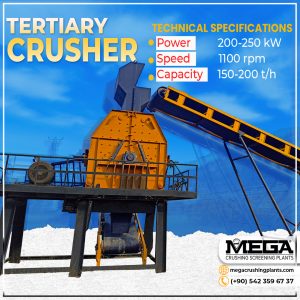MAIN TYPES OF CRUSHERS
INTRODUCTION
In the world of industrial equipment, crushers are a crucial part of crushing and screening plants. These machines we called crushers have differernt types are the backbone of material processing operations, as they break down large rocks and stones into smaller, more manageable sizes for various industries. Let’s take a closer look at the different types of crusher, their importance, what can they do and their abilities. There are different types of crushers and we tried to explain 4 of them bellow.
What Are The Main Types Of Crushers?
1. Jaw Crushers
These are robust and reliable machines that use a fixed jaw and a moving jaw to crush the material. They can efficiently handle large feed sizes and are commonly used in the primary crushing stage.
2. Impact Crushers
These crushers use highspeed impact force to break down materials. They feature a highspeed rotor and are suitable for processing medium hard to hard materials, making them excellent for producing aggregates for construction projects.
3. Cone Crushers
Work by crushing materials between a fixed cone and a spinning mantle. They’re flexible machines used after primary crushing to make cube shaped aggregates. Cone crushers are great for secondary and tertiary crushing steps.
4. VSI Crushers
Have a highspeed spinning rotor that smashes materials against anvils. These crushers excel at shaping aggregates, like manufacturing sand from rocks. VSI Crushers efficiently produce specific particle shapes.
Check our blog to know more about VSI Crushers, CLICK HERE.
5. Hammer Crushers
One of the type of crusher is Hammer Crushers that otating hammers hit and crush materials against the crusher walls. Brittle substances, such as limestone or coal, are perfectly suited for these types of crushers. Hammer Crushers are perfect for shattering brittle materials into smaller pieces.
Main Points
Types Of Crushers |
Hardness | Abrasiveness | Size Reduction Ratio |
Applications |
Jaw Crushers |
Soft to very hard |
No limit |
3/1 to 5/1 |
Heavy mining, quarried materials, sand & gravel, recycling. |
Gyratory Crushers |
Soft to very hard |
Abrasive |
4/1 to 7/1 |
Heavy mining, quarried materials. |
Cone Crushers |
Medium hard to very hard |
Abrasive |
3/1 to 5/1 |
Quarried materials, sand & gravel. |
Compound Crusher |
Medium hard to very hard |
Abrasive |
3/1 to 5/1 |
Mine, building materials. |
Horizontal Shaft Impactors |
Soft to medium hard |
Slightly abrasive |
10/1 to 25/1 |
Quarried materials, sand & gravel, recycling. |
Vertical Shaft Impact Crusher (Shoe and Anvil) |
Medium hard to very hard |
Slightly abrasive |
6/1 to 8/1 |
Sand & gravel, recycling. |
Vertical Shaft Impact Crusher (Autogenous) |
Soft to very hard | No limit | 2/1 to 5/1 |
Quarried materials, sand & gravel. |
5.1 Jaw Crusher Specifications
5.1.1. Key Components
- Fixed Jaw Plate: The stationary part of the crusher.
- Movable Jaw Plate: The moving part that exerts force on the material.
- Pitman: The part that transfers motion to the movable jaw.
- Toggle Plates: These create a safety mechanism and transfer crushing force.
- Flywheel: Stores energy and helps maintain consistent crusher operation.
- Eccentric Shaft: Rotates to provide the crushing action.
5.1.2. Features and Benefits
- High Crushing Ratio: Capable of crushing large pieces into smaller, manageable sizes.
- Simple Structure: Jaw crushers have a straightforward design that makes them easy to operate and maintain.
- Versatility: Suitable for a wide range of materials, including hard, abrasive rocks.
- Adjustable Settings: The output size can be adjusted by changing the distance between the fixed and movable jaw plates.
- Durability: Built with robust materials to withstand the high-impact forces during operation.
- High Capacity: Efficiently handles large volumes of material.
5.1.3. Applications
- Mining: Crushing ores and other hard materials.
- Construction: Producing aggregate for building roads, bridges, and other infrastructure.
- Demolition Recycling: Breaking down construction and demolition waste for recycling.
- Quarrying: Reducing the size of large rocks extracted from quarries.
5.1.4. Types of Jaw Crushers
- Single Toggle Jaw Crushers: Feature one moving jaw that operates with an eccentric shaft. They are simpler, lighter, and more compact.
- Double Toggle Jaw Crushers: Have two toggle plates and two shafts. These are heavier, more robust, and suitable for crushing hard, abrasive materials.
5.1.5. Maintenance
Regular maintenance is essential to ensure the longevity and performance of jaw crushers:
- Check and Replace Wear Parts: Monitor and replace worn jaw plates, cheek plates, and toggle plates.
- Lubrication: Keep bearings and other moving parts well-lubricated.
- Tighten Loose Bolts: Regularly inspect and tighten any loose bolts.
- Clear Blockages: Ensure the feed hopper and discharge area are free of obstructions.
5.2. Impact Crushers
Primer impact crushers are machines used to crush materials by utilizing the impact force. They are commonly used in the mining and aggregate industries for primary crushing operations. Here is detailed information about primer impact crushers:
5.2.1. Basic Principle
Primer impact crushers operate on the principle of impact rather than pressure to reduce the size of materials. The material is fed into the crusher, and as it falls through, it is struck by blow bars fixed on a rotor that rotates at high speed. This impact causes the material to break down into smaller pieces.
5.2.2. Key Components
- Rotor: The central part of the crusher that holds the blow bars and spins at high speed.
- Blow Bars: High-wear resistant bars that impact the material to crush it. These are replaceable parts.
- Impact Plates (Breaker Plates): Stationary plates that the material impacts after being struck by the blow bars.
- Feed Hopper: The entry point for the material being fed into the crusher.
- Discharge Opening: Where the crushed material exits the crusher.

5.2.3. Features and Benefits
- High Reduction Ratio: Primer impact crushers are capable of achieving a high reduction ratio, reducing large rocks into smaller pieces efficiently.
- Versatility: Suitable for various types of materials, including soft, medium-hard, and hard stones.
- Adjustable Settings: The size of the final product can be adjusted by altering the distance between the rotor and the impact plates.
- High Capacity: These crushers can handle large amounts of material, making them suitable for high-volume operations.
- Energy Efficiency: Modern designs are optimized for energy efficiency, reducing operational costs.
- Durability: Made with robust materials and designed for long-term use, requiring minimal maintenance.
5.2.4. Applications
- Quarrying: Used for crushing large stones and rocks into smaller, more manageable pieces.
- Mining: Crushing ores and other raw materials extracted from the earth.
- Recycling: Breaking down materials such as concrete and asphalt for reuse in new construction projects.
- Construction: Preparing materials for use in construction projects, including roads, buildings, and bridges.
5.2.5. Types of Primer Impact Crushers
- Horizontal Shaft Impact (HSI) Crushers: Feature a horizontal rotor and are used for primary, secondary, or tertiary crushing.
- Vertical Shaft Impact (VSI) Crushers: Feature a vertical rotor and are used primarily for producing sand and fine aggregates.
5.3. Cone Crusher
5.3.1. Basic Principle
Cone crushers operate on the principle of compressive crushing. The material is fed into the crusher from the top, and it is compressed between a moving piece of steel, known as the mantle, and a stationary piece of steel, known as the concave or bowl liner. As the material is compressed, it breaks down into smaller pieces and falls through the bottom of the crusher.
5.3.2. Key Components
- Mantle: The moving part that gyrates inside the concave to crush the material.
- Concave/Bowl Liner: The stationary outer shell that works with the mantle to crush material.
- Feed Hopper: The entry point for the material being fed into the crusher.
- Eccentric Shaft: Provides the gyrating motion to the mantle.
- Drive Mechanism: Includes motors, gears, and belts that drive the eccentric shaft.
- Hydraulic System: Used to adjust the gap between the mantle and concave, and for clearing blockages.
5.3.3. Features and Benefits
- High Efficiency: Cone crushers provide high production efficiency with a consistent product shape.
- Versatility: Suitable for a wide range of materials, including hard and abrasive stones.
- Adjustable Settings: The size of the final product can be adjusted by changing the gap between the mantle and the concave.
- Durability: Made with robust materials and designed to handle high-stress conditions.
- High Capacity: Capable of handling large volumes of material.
- Safety Features: Equipped with overload protection systems and hydraulic clearing mechanisms to prevent damage.
5.3.4. Applications
- Mining: Crushing ores and rocks to extract valuable minerals.
- Aggregate Production: Producing gravel, sand, and other aggregates for construction.
- Construction: Crushing materials for use in building roads, bridges, and other infrastructure projects.
- Recycling: Breaking down concrete, asphalt, and other materials for reuse.
5.3.5. Types of Cone Crushers
- Spring Cone Crushers: Use a spring mechanism to protect against overload and allow uncrushable materials to pass through without damaging the crusher.
- Hydraulic Cone Crushers: Use hydraulic systems for adjusting the gap, clearing blockages, and providing overload protection.
- Compound Cone Crushers: Combine the advantages of both spring and hydraulic cone crushers.
- Symons Cone Crushers: A type of compound crusher with high performance and standard configurations.
5.3.6. Maintenance
Regular maintenance is essential to ensure the longevity and performance of cone crushers:
- Check and Replace Wear Parts: Monitor and replace worn mantles and concaves.
- Lubrication: Keep bearings and other moving parts well-lubricated.
- Inspect Hydraulic System: Regularly check the hydraulic system for leaks and proper operation.
- Tighten Loose Bolts: Ensure all bolts are secure.
- Clear Blockages: Use the hydraulic system to clear blockages safely.
Size is vital as crushers can only handle materials up to specific sizes.
Match the crusher to the feed’s dimensions. Different crushers work best for different feed sizes.
Crusher capacity is key what you need dictates which crusher type and size.
Throughput varies across machines, so match the capacity needs. Output requirements determine the right crusher model.
Material hardness matters match the crusher strength to the rock’s toughness.
This optimizes performance and reduces wear on the machine. The crushers which are manufactured for soft material won’t work well on hard rocks, and vice versa.
Cone crushers make cubical shaped gravels best. But other shapes need different crusher types. Know your desired output and choose accordingly.
Visit our blog “Crushing and Screening Plants For Sale” to know our products more.
Enhancing Efficiency Of Main Types Of Crushers
- Regular inspections identify potential issues early. This prevents unexpected downtime and costly repairs.
- Proper lubrication of crusher components reduces friction and wear. Ensuring lubrication is crucial.
- Operational parameters like closed side setting (CSS) optimize crusher settings. This achieves desired product size and maximizes throughput.
- Training operators on safe and efficient crusher operation maximizes productivity. It also ensures safety.
Innovative Future Ahead
Ongoing technological advancements and excellence commitment promise enhanced efficiency, sustainability, and productivity for material processing operations worldwide. The day we publish this blog is “Earth Day” and for more sustainable and healty environment we are producing eco-friendly products to satisty both our customers and the nature. The future of crushing and screening plant crushers looks promising. To understanding Main Types Of Crushers and their aspects is crucial to start your business smoothly. We are here as MEGA Crushing Plants to help you on this journey and be your collobrative partner.
What you are thinking about working with us as a partner, We as MEGA Crushing And Screening Plants waiting for your contacts.





